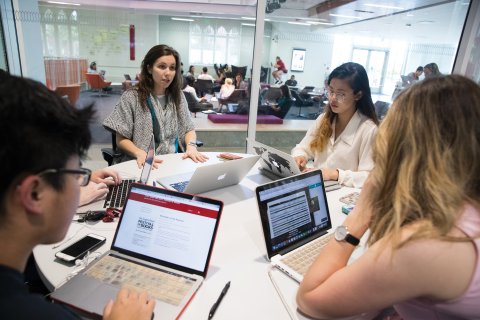With the digital media revolution well underway, news organizations have invested a couple decades’ worth of innovation into their online presence. Longtime observers and news junkies have watched as website design advanced in leaps and bounds.
Young audiences, though, don’t quite see it that way.
Imagine never being a print newspaper reader. If your parents and your teachers never subscribed. If you were not romantically entangled with the memories — the smell of fresh newsprint, the impact of a headline above “the fold,” the arrest of a great “double-truck.”
You would read information differently. You would consume news differently.

And it’s not just about aesthetics. Davis was inspired to develop the class after reading research that shows readers actually lose trust in news sources that are difficult to use. When the news delivery is wonky — if it loads slowly, is blocked by ads or is cluttered — the audience ties that inefficiency to the journalism itself.
As news orgs like The New York Times move away from an advertising-based revenue model to one built on digital subscriptions, the need to engage with audiences and build trust is greater than ever. Connecting with readers is no longer a way to bolster advertiser ranks. In itself it’s crucial to survival.
“The power structure of journalism has been radically altered,” said Davis, assistant professor of professional practice and Annenberg Media’s digital news director. “Journalists have to worry so much more now about how their work reaches audiences. They need to be thinking about their audience and what it means for them to have a good user experience. It’s absolutely vital now.”
Davis has teamed up with lecturer Jenn de la Fuente to co-teach a new directed research class that focuses on intense critical thinking about the news user experience. The class will culminate in the design of a journalism product, along the lines of a “news concierge” app that strengthens the relationship between readers and journalists. The goal will be to foster a direct connection between readers and the editors who curate the app’s news, chat with readers, offer context and win their trust.
As the app moves into the development stages, it will be deployed by student-run Annenberg Media. The value is not only to bolster delivery of news but also to help student journalists incorporate the user experience into the journalism they produce. If they’re involved in the day-to-day delivery of news, and are responsible for it connecting with audiences, they are more likely to understand the stakes and be able to translate it into a sustainable skill in their careers as journalists.
“I think every journalist needs a little product-thinking to bleed through all of their work,” Davis said. “It’s really important for them to think about putting readers and users first.”
As JOUR 490 delved into that critical thinking, and students posted publicly, something else happened. Their voices found an audience.
Davis’ post, shared via Medium, is titled: “Dear news media: Here’s what your future audience wants you to fix.” And sophomore James Tyner, 19, wrote a post that has been viewed more than 12,000 times and was an Editor’s Pick on Medium. His “Dear news media: Create news for people who have never read a newspaper” has been shared by almost 500 readers. He’s been contacted by industry leaders at national outlets interested in his point of view, including USA Today. The American Press Institute (API) has featured fellow student Darrell Florence’s piece in its daily “Need to Know” newsletter, aimed at thought leaders and digital media executives.
The customer is always right
“Eventually, for publishers to succeed long-term, they will need to offer news products that Millennials will pay for,” said Will Federman, who graduated in 2015 with a bachelor’s degree in journalism. “If you don’t offer an experience Millennials are willing to pay for, they won’t pay for it.”
It’s a bottom line that seems like a no-brainer, but news delivery models have been top-down for so long, that the reckoning has been slow to arrive.
“My No. 1 takeaway, after two years in the industry, is that it’s terrible at customer service,” said Federman, whose first job out of USC Annenberg was managing audience engagement for Fortune magazine.
“The user is the customer. If you want to afford the journalism you want to produce, you need customers who will pay for it. And customers are unsatisfied.”
Within a year of graduating, he was leading his team. He’s now managing editor of Tylt, an online debate forum launched last year by Advance Digital’s start-up incubator. The site’s team is expanding offices in New York and San Francisco, and 70 percent of its audience is under 40.
Federman learned during his time at Fortune, collaborating with colleagues at parent company Time Inc., that even legacy news orgs are finally understanding. “They need fresh eyes to infuse the industry with the kind of energy and innovation it needs to succeed in the long run,” he said.
“A lot of the skills I’m seeing students graduate with now are more in demand and more appreciated at legacy organizations, in particular, than I’ve seen in years past. A few of us have worked our way up pretty quickly,” Federman said.
Along with every imaginable channel of communication, the newsroom hierarchy itself has been turned inside out by the digital revolution. But it’s not just next-generation skills that are finally coming into their own in newsrooms.
It has started to click with industry leaders that these cub reporters are more than future news producers — they’re news consumers. Cub reporters still learn on the job, but as digital natives, their input is valued in an entirely new way.
That’s where Davis’ and de la Fuente’s students – and their USC Annenberg classmates — come in.
“This is going to be their audience for the next 60-70 years,” Davis said. “This is who, frankly, they should be thinking about. I’m not sure the industry realizes how much their habits don’t make sense outside their little media bubble.”
‘It’s how all relationships work.’
“Hey, news industry, you’re doing it wrong,” reads the first line of Tyner’s Medium piece.
He dives right in, with a screengrab of The Washington Post’s home page.
“Take a look at this site. There’s a lot of great content. But where do I start if I don’t have all the time in the world and want to meaningfully engage with the news? Do I start with the topics at the top and work my way down? Do I start with one of the videos? Do I follow the size of the text from largest to smallest? There are just so many words on this page with no sense of order, it’s not clear what the news actually is.”
It’s a layout “we’d expect from a newspaper,” he writes. “But something created for a young and sophisticated audience needs better design, better visual hierarchy and more color. We grew up in the age of iPod ads, and for us, design matters.”
In conversation, Tyner strips it bare in a way that comes down even harder on old news norms. “A younger audience doesn’t care what a newspaper looks like,” he said. “They never read them and never will. It’s not the way to go about presenting news if you’re trying to build something for the future.”
In his Medium piece, he goes on to outline other news conventions that don’t make sense to young readers. Why make videos for their own sake, when a text story works better? Why not abridge enterprise stories, so readers can consume content on their own terms? Why don’t sites like Vox explicitly discuss their point of view, instead of making readers guess? (“If you’re transparent, people will trust you. It’s how all relationships work.”)
Much of the JOUR 490 writings centered on trust issues. Florence’s piece, the one picked up by API, focused on how much news is delivered with no context. And that’s not a generational complaint, he emphasized. His grandmother, 63, articulated what many of his peers expressed — that too often, the news starts in the middle of the story, gives no background, doesn’t frame itself, doesn’t explain the sourcing. Readers are trying to understand a language they don’t speak and are left feeling they don’t understand what is truly happening. It’s like accidentally sitting down at the cool kids’ table and realizing you’re totally alone in the world, he writes.
“Consumers,” he said, feel “lost in the world.” They are being talked down to. There goes the trust.
In fact, research conducted last year by The Media Insight Project, a collaboration of the API and The Associated Press-NORC Center for Public Affairs Research, revealed that multiple factors of news delivery affect how much people trust news.
Accuracy and being up-to-date were of utmost importance to those polled for the study, when asked why they rely on a particular news source. When it comes to trust, 70 percent said that citing expert sources and data is important.
That a news account be “concise and get to the point” was significant to 72 percent and being able to navigate a site to easily find news and information was critical to 70 percent.
“In other words, having something be navigable, clear and easy to use is a key part of whether people rely on it and value it,” the report concluded.
And trust is critical to the vitality of news sources. The study found that those who said they valued trustworthiness the most are the ones more likely to report that they pay for news, share it and follow it on social media.
But a highlight of the study that resonated with Davis — and inspired the development of JOUR 490 — was a finding related specifically to young audiences. The report found that young news consumers place greater importance on “load times, ease of use on mobile phones, lack of interference from ads and inclusion of hyperlinks.”
For future news consumers, product experience is paramount. “Bad ads affect how people feel about content creators. A good product experience can restore trust in news,” Davis said. “I zeroed in on that.”
What’s next
Not all of the reaction to the students’ writing was a lovefest. Tyner got some blowback from people who said he should offer more solutions in addition to pointing out the problems with news delivery.
Enter part two of Davis’ and de la Fuente’s class: product development. Students are working to incorporate their critical thinking into a design experience that makes sense, and to make their app customizable. Students identified ways to make the tool feel like a personal news guide. With one overarching goal in mind: restoring trust.
“Laura and Jenn never say, ‘modify the old news model and make it newer,’” Tyner said. “It’s always, ‘How can we make something new?’ It’s always focused on the audience and user. Because for something to resonate with people, it has to be what they want rather than what the reporter wants.”
Turns out, that’s exactly the theme Davis and de la Fuente want to leave their students with.
“We can’t control what the audience does,” David said. “That is not our place. I’ve gotten the sense from legacy publications that they believe they know what’s best, and the audience should conform. That is a failing strategy.
“You have to serve them. You have to let go of your way of doing things.”
The onus should be on all news organizations to improve the news user experience. But places like USC Annenberg are in a unique position to lead, with more room to explore and offer outsider critique.
“I think it’s important that it comes from the students,” de la Fuente said. “We are arming them with the right tools and right way of thinking, and they can push the agenda forward.
“If a small crack has opened — maybe they can make a chasm and run through it.

